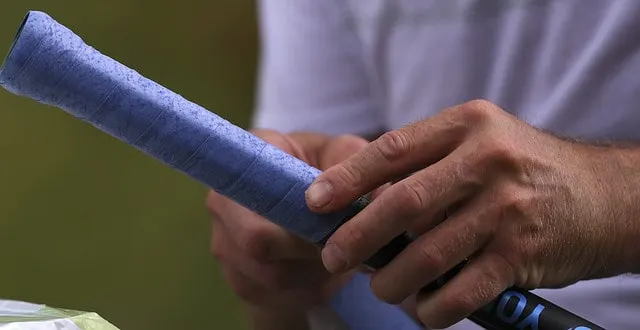
When it comes to changing or replacing your tennis gear, it’s usually the racket and strings which first spring to mind.
However, the grip on your tennis racket also needs to be changed too, and it might be more often than you think.
If you find the racket slipping out of your hand when you’re playing, then it doesn’t matter how good your racket or strings are, you’re going to start missing a lot of shots because your grip needs to be replaced.
How Often Do You Need To Replace Your Tennis Grip?
Unfortunately this isn’t a straightforward answer as it depends how much you sweat, how hot it is when you’re playing matches, and how often you play tennis.
Another factor is whether you use a replacement grip or an overgrip.
This article will look at the pros and cons of replacement grips vs overgrips in tennis.
What Is An Overgrip In Tennis?
This is simply a thin grip which basically wraps around your main grip.
Pro players usually apply a new overgrip every time they play, but it’s not necessary for most recreational tennis players.
However, if you live in a hot climate, or you’re prone to sweating a lot when you play, you might find you need to add a new overgrip quite often.
How Do You Apply a Tennis Overgrip?
Start from the butt of the racket and gradually wrap it around the handle overlapping by about half a centimetre (1/6 inch) as you go. Once your reach the top of the handle, cut it off and hold it in place with some tape.
Here’s a video demonstrating how it’s done.
Pros and Cons of Using An Overgrip
Here are the advantages of playing with an overgrip.
- Provides extra softness and cushioning on your grip.
- Improves sweat absorption.
- Adds extra stickiness so you can grip the racket better.
- Overgrips come in all colours so you can personalize your racket a bit more!
- Cheaper to replace than having to change the whole grip.
- It’s quicker to replace than the main grip (if you have to change one quickly during a match)
The only real disadvantage is that you have to change it a lot more often than the main grip, which can be inconvenient if you play regularly and even more so if you don’t have a sports shop near you. It’s probably best to buy in bulk if want to use overgrips!
It also increases the overall grip size which might be a bit uncomfortable for some people, especially if your main grip is quite bulky in the first place.
Pros and Cons of Replacement Grips
Here are the advantages of just replacing your grip (and not use an overgrip at all)
- You don’t have to change it that often. It lasts a lot longer than an overgrip.
- Although an overgrip is cheaper, taking into account the lifespan of a racket, how often you play and how often you need to change your grip, it might be cheaper overall to just replace the main grip once in a while.
Although replacement grips last longer, they will still lose their stickiness and feel over time, especially if you play regularly and/or sweat a lot when you play. In either of these cases using an overgrip will probably be better.
Which Is The Most Popular Brand For Tennis Overgrips?
In the chart below you can see that Wilson is the most popular choice for tennis players when it comes to choosing an overgrip (based on online search volume in the search engines)

Conclusion – Which is the better option?
Using an overgrip seems by far the most popular option.
Most pros use them, although I believe Tim Henman and Leyton Hewitt never used one when they played competitive tennis.
It’s a similar pattern with club and rec players too. According to a poll over at the Tennis Warehouse, 87.5% of players prefer playing with an overgrip.
